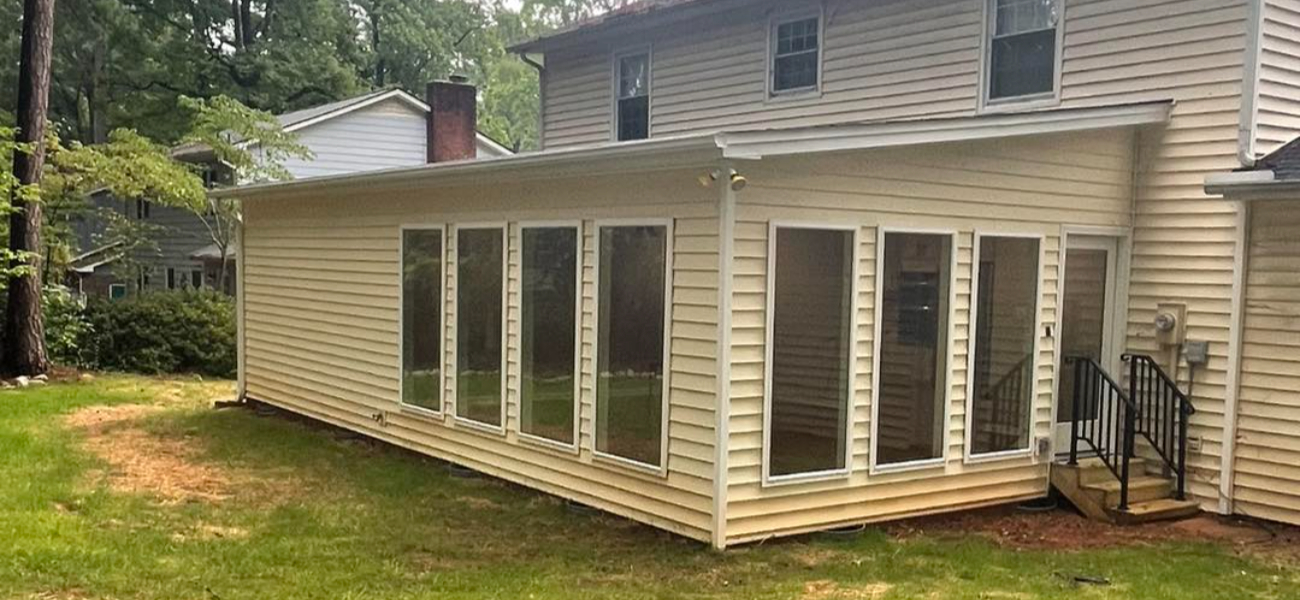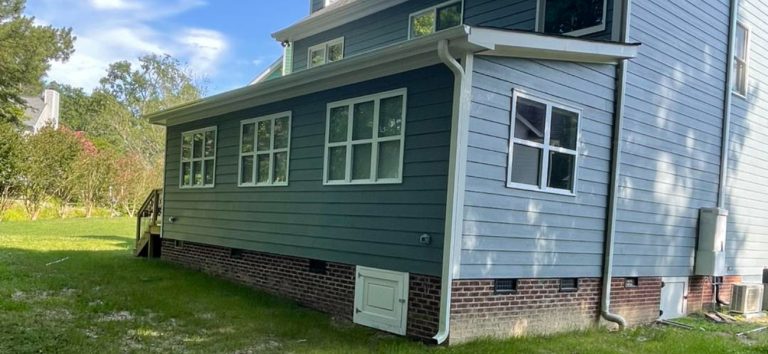3-Season vs. 4-Season Sunrooms
Adding a sunroom is one of the most effective ways to bring natural light and year-round enjoyment into your home. Whether you want a cozy retreat for morning coffee, a bright family room, or a peaceful space to enjoy the outdoors without worrying about the weather, a sunroom delivers beauty, comfort, and value.
But before you begin your project, one major decision will shape the design and budget: should you build a 3-season sunroom or a 4-season sunroom?
At Branch Home Remodeling, we help homeowners throughout Wake County and surrounding areas design and build custom sunrooms that match their lifestyle, property, and goals. This guide breaks down the differences between 3-season and 4-season sunrooms, including cost, comfort, and functionality, so you can make the right choice for your home.
What is a sunroom?
A sunroom is an enclosed addition that features large windows or glass walls to maximize natural light and outdoor views. It blends the comfort of indoor living with the openness of the outdoors. Unlike patios or screened porches, sunrooms are fully enclosed, making them usable for more of the year.
Sunrooms are ideal for:
-
- Morning relaxation or reading spaces
- Indoor gardens or plant rooms
- Extended family dining areas
- Home offices with natural light
- Playrooms or entertaining spaces
Branch Home Remodeling designs and builds every sunroom to complement your home’s architecture while enhancing energy efficiency and comfort.
Understanding 3-season and 4-season sunrooms
The biggest difference between these two sunroom types comes down to insulation, temperature control, and year-round usability.
3-season sunrooms
A 3-season sunroom is designed for use during the spring, summer, and fall months. It’s enclosed with high-quality windows and doors but typically lacks the full insulation or HVAC connections of a traditional room addition.
Key characteristics:
-
- Designed for mild to warm weather.
- Uses single-pane or non-thermal windows.
- Often built with lightweight framing systems.
- Can include ceiling fans or portable heaters for comfort.
- Typically not connected to your home’s heating and cooling system.
These rooms let you enjoy the fresh air and sunlight while being protected from bugs, wind, and rain. However, they may be too cool during winter or too warm in peak summer without supplemental temperature control.
4-season sunrooms
A 4-season sunroom is engineered for year-round comfort. It’s fully insulated and integrated into your home’s HVAC system, making it feel like a true interior room.
Key characteristics:
-
- Built with insulated, energy-efficient windows and walls.
- Features full thermal protection for temperature regulation.
- Uses sturdy framing materials like vinyl, wood, or insulated aluminum.
- Connected to your home’s heating and cooling system.
- Comfortable to use in all seasons, including winter and summer extremes.
While 4-season sunrooms require a higher initial investment, they offer superior comfort, versatility, and long-term value.
1. Comfort and usability
When comparing 3-season and 4-season sunrooms, comfort is the most noticeable difference.
A 3-season room offers an excellent balance of affordability and usability for most of the year, especially in mild North Carolina climates. However, without full insulation, the room’s temperature fluctuates with the weather.
A 4-season sunroom, on the other hand, maintains consistent comfort year-round. Its insulation, thermal windows, and HVAC integration make it perfect for everyday living, whether you’re reading on a chilly winter morning or hosting friends during summer heat.
Branch Home Remodeling helps homeowners determine which option best matches their lifestyle, ensuring that the space is enjoyable no matter the season.
2. Construction and materials
The construction methods for each type of sunroom differ based on the level of insulation and structural requirements.
3-season construction
-
-
- Lightweight framing systems.
- Tempered glass or single-pane windows.
- Minimal insulation in walls and ceilings.
- Optional screens for ventilation.
-
These rooms can often be added onto existing decks or patios, reducing construction time and cost.
4-season construction
-
-
- Insulated walls, floors, and ceilings.
- Double or triple-pane windows with thermal breaks.
- Strong framing materials like insulated aluminum or wood.
- Full integration with the home’s HVAC system.
-
Because they’re designed for year-round use, 4-season sunrooms are built more like traditional home additions, requiring proper engineering, insulation, and permits.
Branch Home Remodeling manages every step from structural engineering and permitting to framing and finishing, ensuring that your new space meets all building codes and blends seamlessly with your home.
3. Cost considerations
The cost of your sunroom depends on its size, materials, and features. In general, 3-season sunrooms are more affordable because they require less insulation, lighter materials, and simpler HVAC integration.
A 4-season sunroom involves a higher investment due to the added insulation, windows, and connection to your home’s heating and cooling system. However, it also adds more livable square footage and resale value.
During the consultation process, Branch Home Remodeling provides transparent pricing and design options to help you choose the right balance between budget and functionality.
4. Energy efficiency and performance
Energy efficiency plays a major role in how comfortable your sunroom will be, and how much you’ll spend to maintain it.
3-season rooms rely on natural ventilation, ceiling fans, and sometimes portable heating or cooling units. They perform well in mild weather but lose heat quickly in colder months.
4-season rooms are built with energy-efficient materials designed to regulate indoor temperatures. With insulated glass, advanced framing, and HVAC connections, they keep energy costs low while maintaining consistent comfort.
Branch Home Remodeling uses high-performance materials and modern construction techniques to ensure every sunroom performs efficiently, regardless of the season.
5. Permits and building requirements
Because 4-season sunrooms are more complex and integrated into the home’s structure, they typically require more permits and inspections than 3-season rooms.
Permitting ensures compliance with local building codes, including:
-
-
- Structural load requirements.
- Electrical and HVAC installations.
- Energy efficiency standards.
- Zoning and setback regulations.
-
At Branch Home Remodeling, we handle the entire permitting and engineering process for you. From submitting drawings to scheduling inspections, our team ensures everything is built safely and legally from the start.
6. Design flexibility and aesthetics
Both 3-season and 4-season sunrooms can be customized to fit your home’s style. However, 4-season rooms generally allow for more integration with existing architecture.
Popular design options include:
-
-
- Cathedral or vaulted ceilings to maximize light.
- Skylights or roof windows.
- Sliding or French doors that open to patios or decks.
- Accent trim, flooring, and finishes that match your main living spaces.
-
Whether you prefer a modern glass enclosure or a traditional sunroom with wood trim and crown molding, Branch Home Remodeling designs each space to enhance your home’s beauty and flow.
7. Return on investment
While 3-season sunrooms are more affordable upfront, 4-season sunrooms tend to provide a stronger return on investment. Because they can be used all year, they effectively expand your home’s livable space and appeal to potential buyers.
Additionally, energy-efficient materials and durable construction reduce maintenance costs over time. For homeowners planning to stay long-term, a 4-season sunroom offers superior value, comfort, and flexibility.
Case example: sunroom addition in Fuquay-Varina
A homeowner in Fuquay-Varina contacted Branch Home Remodeling to replace an outdated screened porch with a functional sunroom. They wanted a space they could enjoy year-round without worrying about drafts or extreme temperatures.
Our team designed a fully insulated 4-season sunroom with large energy-efficient windows, new flooring, and integrated HVAC. The result was a bright, comfortable living space that felt like a natural extension of the home.
After completion, the homeowners reported lower energy costs and a dramatic improvement in how they used their home throughout the year.
Areas we serve
Branch Home Remodeling proudly serves homeowners throughout Wake County, Johnston County, and Harnett County, including:
-
- Apex
- Cary
- Chapel Hill
- Clayton
- Durham
- Fuquay-Varina
- Garner
- Holly Springs
- Morrisville
- Pittsboro
- Raleigh
We’re known throughout the Triangle area for precision craftsmanship, reliable communication, and remodeling results that enhance both comfort and home value.
Ready to build your dream sunroom?
Let’s design a space you’ll enjoy in every season
Whether you’re considering a 3-season or 4-season sunroom, Branch Home Remodeling can help you plan and build the perfect addition for your home. We specialize in home additions, kitchen remodeling, bathroom renovations, attic finishing, and whole-home remodeling throughout Wake County and surrounding communities.
Call us today or request your consultation online to get started. Our team will help you design a beautiful, code-compliant sunroom that fits your budget, lifestyle, and long-term goals, a space that brings the outdoors in and adds lasting value to your home.






